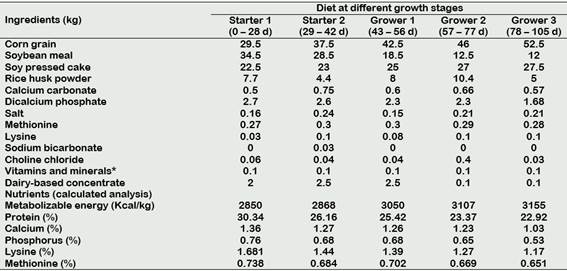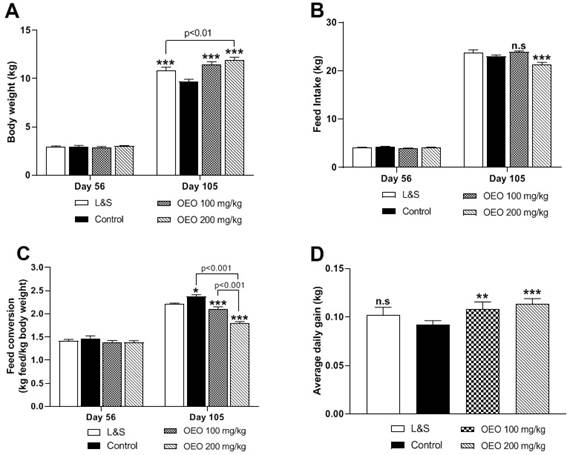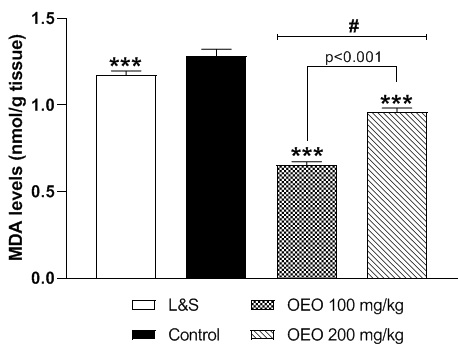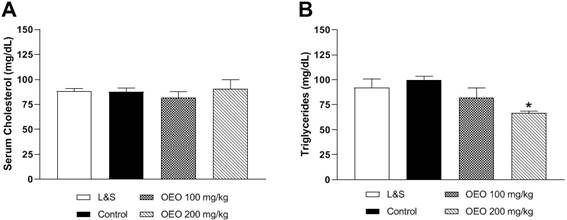Introduction
In poultry farming, the use of antibiotics is intended to prevent diseases and stimulate growth. Therefore, they are typically provided at subtherapeutic doses in the feed to increase production. However, their misuse/overuse contributes to antibiotic resistance, a significant worldwide public health problem (Ardoino et al., 2017; Gatica-Eguiguren and Rojas, 2018). With the increased interest in the nutritional properties of meat, consumption has increased considerably, especially in poultry. Compared to other types of meat, turkey is rich in protein, vitamins, and minerals and low in fat. Importantly, the growth conditions of farm birds are a key factor influencing both the quantity and quality of meat produced (Vaitukaityte et al., 2013). In addition, muscle from turkeys is more sensitive to lipid oxidation during postmortem storage compared with that of chicken and duck (Perez et al., 2019).
Compared to red meat, the meat of farmed birds is more susceptible to lipid oxidation because it has less stable fatty acids (Adeyemi and Olorunsanya et al., 2012). Excess oxidative stress leads to an overall imbalance in redox homeostasis (Łuczaj et al., 2017) and lipid peroxidation, which alters the biological properties of membranes and generates cytotoxic aldehydes, such as malondialdehyde (MDA), who present negative impacts, by causing additional damages to biomolecules (proteins and DNA) and the off-flavors associated to edible fats rancidification (Félix et al., 2019). For this reason, this aldehyde has great importance in meat because at low amounts it produces rancid aromas, and it is the major marker of lipid oxidation (Domínguez et al., 2020). Furthermore, transport of animals and environmental conditions have also been shown to increase oxidative stress in the meat (Hcini et al., 2018). Hence, antimicrobials are typically used as growth promoters for farmed birds and other animals (Xiong et al. 2018).
Concerns about antibiotic-resistant microorganisms, coupled with the growing demand for high-quality animal protein free of antibiotics and harmful compounds, has initiated a demand for new alternative functional feeding strategies (Kiarie et al., 2016). Since ancient times, essential oils have been used due to their beneficial effects on humans and animals. They have been widely used for antibacterial, antiviral, fungicidal, anticancer, and cytotoxic activities, among others (Stevanović et al., 2018). Oregano essential oil (OEO) has been recognized for its antimicrobial and antioxidant properties. OEO has also been shown to be more effective against grampositive bacteria than gram-negative, the main compounds in OEO responsible for these properties are carvacrol and thymol, both of which are present regardless of geographical area, species, or harvest season (Rodriguez-Garcia et al., 2016).
The nutrition of farmed turkeys is critical because their bodily and digestive functions are fast, thereby accelerating its growth. Therefore, the turkey diet requires effective growth promoters that not only control the bacterial load of the digestive tract, but also contribute to the quality of the meat. The present study evaluated the effect of supplementation with oregano (Origanum vulgare) essential oil (OEO) on the productive parameters, oxidative stability, and lipid parameters of turkey meat.
Materials and methods
Animals, diets, and experimental design
The turkeys (Meleagris gallopavo) were provided by a local farm located in Santo Domingo (Laredo, La Libertad, Peru). Dietary and productive parameter analyses were carried out in the Laboratorio de Nutrición Animal of the Facultad de Ciencias Agropecuarias of the Universidad Nacional de Trujillo (Trujillo, La Libertad, Peru), while oxidative stability and lipid profile analyses were done in the Laboratory of Pharmacology of the Faculty of Pharmacy and Biochemistry. This study was approved by an animal ethics committee and adhered to the code of ethics for research at the Universidad Nacional de Trujillo.
Eighty 1-d-old male turkeys were equally distributed into four dietary treatment groups (n = 20 per group), and each group was housed in one pen under conventional conditions with access to food and water ad libitum and 12-h photoperiod. The treatment groups were as follows: control diet, standard feed without supplements; L&S diet, standard feed supplemented with 300 mg/kg lincomycin and spectinomycin; OEO100, standard feed supplemented with 100 mg/kg OEO; OEO200, standard feed supplemented with 200 mg/kg OEO.
Table 1 Dietary contents supplied from day 0 to 105

*per kg contains 10 000 000 IU vitamin A, 3 000 00 IU vitamin D3, 15 000 IU vitamin D, 2.5 g vitamin K3, 2 g vitamin B1, 8 g vitamin B2, 4 g vitamin B6, 0.012 g vitamin B12, 20 g vitamin B5, 1.5 g vitamin B9, 70 g vitamin B3, 0.2 g vitamin B7, 70 g manganese, 70 g zinc, 80 g iron, 10 g copper, 1 g iodine, 0.3 g selenium, and excipients.
The experimental period lasted 15 weeks. The diets (Table 1) were prepared monthly; the food was granulated and mixed with a mixer with a 250 kg capacity. The diets were formulated using ZMix iT® software (version 3.1, Zootech E.I.R.L., Lima, Peru). The experimental diets were formulated according to the requirements previously described by Rostagno et al. (2017) and divided according to the days of the experiment. The OEO was microencapsulated and supplemented in the feed.
Measurements and sample collection
Feed intake (kg) and body weight (kg) were recorded weekly. Feed conversion was calculated weekly as consumed food (kg) divided by live weight (kg) for each treatment. The average daily gain was calculated from the total increase in weight (kg) divided by the total days of the experimental period. At the end of the experimental period, thigh meat and blood samples were taken from each group for oxidative stability testing using thiobarbituric acid reactive substances (TBARS) and cholesterol and triglyceride analyses, respectively.
Oxidative stability
Oxidative stability was measured as described by Maraschiello, et al. (1999) with slight modifications. Briefly, 0.5 g of thigh meat was weighed and homogenized in 5 mL of deionized water, then vortexed for 1 min. Next, 2.5 mL of cold 25% (w/v) trichloroacetic acid (TBA) was added to the homogenate, followed by gentle stirring at 4 °C for 15 min and centrifugation for 15 min at 13000 × g and 4 °C. A 3.5 mL aliquot of the supernatant was taken and transferred to a test tube, 1.5 mL of 0.6% (w/v) aqueous 2-TBA added, and tubes incubated at 70 °C for 30 min. Then, the tubes were cooled in room temperature and the absorbance recorded at 532 nm against a blank consisting of 2.5 mL of deionized water, 1 mL of 25% aqueous TBA, and 1.5 mL of 0.6% TBA. The calibration curve was performed using the external standard method with a 1, 1, 3, 3-tetraethoxypropane concentration series.
Lipid parameters
On the final day of the experiment (day 105) between 08:00 and 12:00, blood samples taken from the wing vein in tubes without additives. These samples were transported to the Laboratorio de Farmacología of the Facultad de Farmacia y Bioquímica of the Universidad Nacional de Trujillo, where they were centrifuged at 3000 rpm for 10 min and the serum transferred to new Eppendorf tubes and stored at -80 °C. In addition, thigh meat samples from all birds were subsequently obtained and stored in Eppendorf tubes until analysis (up to 3 months).
Statistical analysis
The experiment was designed with a completely randomized design. One-way analysis of variance (ANOVA) with Tukey post-test was used to determine productive parameters, oxidative stability, cholesterol, and triglycerides. A P ≤ 0.05 was considered statistically significant. Values are expressed as the mean ± standard error of the mean (SEM), and all statistical analyses were performed using GraphPad Prism software (San Diego, CA, USA).
Results and discussion
Turkey performance
Nutritional supplementation with oregano and its extracts have antioxidant, growthstimulating, antimicrobial, and immunostimulant properties in poultry. While the antioxidant benefits of bioactive components of oregano have been previously shown to protect the quality of poultry meat and its derivatives (Alagawany et al., 2018), most of these investigations were carried out in broilers. Therefore, the present study investigated the effect of dietary OEO supplementation on the productive parameters, oxidative stability, and lipid profiles of male turkeys.
Supplementation with OEO significantly increased (p < 0.001) the body weight of turkeys (OEO100: 11.42 ± 0.33 kg; OEO200: 11.94 ± 0.27 kg) compared to the control group (9.7 ± 0.22 kg; Figure 1A). Likewise, the body weight of L&S group turkeys was also significantly increased (10.8 ± 0.37 kg, p < 0.001). However, the L&S group was significantly overcome (p < 0.01) by the OEO200 group. In accordance with our research, Chang-Song et al. (2017) observed that oregano powder significantly improved body weight of broiler chickens compared to control, although it failed to overcome virginiamycin treatment. This also suggests that supplementation with OEO is more effective than oregano powder. Furthermore, treatment with the higher concentration of OEO (200 mg/kg) achieved the greatest body weight, consistent with research by Galal et al. (2016). This effect has been shown to plateau from 300 to 600 mg/kg OEO by Peng et al. (2016), and Mohiti-Asli and Ghanaatparast-Rashti (2017) showed the beneficial effects of 300 ppm OEO supplementation on weight exceeded that of 500 ppm OEO and control groups.

Figure 1 Effect of oregano essential oil (OEO) on body weight (A), feed intake (B), feed conversion (C), and average daily weight gain (D) of turkeys. *P < 0.05, **P < 0.01, ***P < 0.001 versus control. L&S, 300 mg/kg lincomycin and spectinomycin; n.s., not significant.
Interestingly, feed intake was significantly reduced in the OEO200 group (21.34 ± 0.4 kg) compared to control (23 ± 0.26 kg, p < 0.001; Figure 1B), but not in OEO100 or L&S birds. Although aromatic herbs and essential oils can improve taste and palatability, thereby increasing consumption (Skoufos et al., 2016), the opposite was found in the current and previous studies. Peng et al. (2016) and Mohiti-Asli and Ghanaatparast-Rashti (2017) have also shown that as the concentration of dietary OEO increases, consumption decreases. On the other hand, other investigations did not show this same effect of the OEO in quails and chickens (Badiri and Saber, 2016; Galal et al., 2016).
Like intake, feed conversion significantly decreased (p < 0.001) with increasing OEO concentration (OEO100: 2.1 ± 0.05; OEO200: 1.79 ± 0.04) compared to control (2.37 ± 0.04; Figure 1C). The reduction with OEO200 was even more significant (p < 0.001) than the L&S group (2.21 ± 0.02). Carvacrol and thymol, active components of OEO, are known to improve the rate of food conversion via inactivation of insulin in the liver (Lee et al., 2003a). In addition, The OEO have been shown to increase the height of ileal villi, reduce crypt depth, increase lactic acid bacteria, and reduce coliform populations in the ileum and cecum (Skoufos et al., 2016; Peng et al., 2016). Nonetheless, despite this evidence, many studies have reported that OEO does not exhibit a statistically significant positive effect in chickens and quails (Badiri and Saber, 2016; Galal et al., 2016; Skoufos et al., 2016; Peng et al., 2016; Mohiti-Asli and Ghanaatparast-Rashti, 2017).
Average daily weight gain also improved significantly with OEO supplementation (OEO100: 0.108 ± 0.003 kg, p < 0.01; OEO200: 0.113 ± 0.006, p < 0.001) compared to control (0.09 ± 0.002 kg; Figure 1D), while the L&S group gains did not significantly differ. These results are consistent with those of Peng et al. (2016) showing oregano powder improves average daily gain versus control. In contrast, Chang-Song et al. (2017) reported that average daily gains with oregano powder did not exceed that with antibiotic treatment. This suggests that OEO is more effective than oregano powder with respect to weight gain.
Oxidative stability
Oxidative processes have been the focus of animal and meat scientists for decades due to the negative impact of these reactions on animal growth, yield, and food quality (Estévez, 2015). Poultry meat is particularly susceptible to oxidation mainly due to the high degree of unsaturated fatty acids as well as the presence of catalysts and molecular oxygen (Min and Ahn, 2005). In addition, Salih et al. (1989) reported that turkey thigh meat was more susceptible to oxidation than turkey breast meat.
The present study found that supplementation with OEO and L&S significantly reduced (p < 0.001) MDA levels in turkey thigh meat (OEO100: 0.65 ± 0.01 nmol/g; OEO200: 0.96 ± 0.01 nmol/g; L&S: 1.17 ± 0.01 nmol/g) with respect to control (1.28 ± 0.04 nmol/g; Figure 2). Both OEO concentrations also had significantly lower MDA levels than the L&S group (p < 0.001). In addition, OEO100 had the greatest effect on MDA levels versus OEO200 (p < 0.001). The presence of thymol and carvacrol explain the in vivo antioxidant effect of oregano essential oil (Yanishlieva et al., 2006). Thymol has been shown to increase the activity of endogenous antioxidant enzymes, such as superoxide dismutase, catalase, glutathione peroxidase, and glutathione-S-transferase, as well as the level of other nonenzymatic antioxidants, such as vitamin C, vitamin E, and reduced glutathione (Salehi et al., 2018). Likewise, thymol and carvacrol supplementation have been shown to increase antioxidant status and decrease MDA levels in broilers (Zidan et al., 2016; Hashemipour et al., 2013).
A previous study by Florou-Paneri et al. (2005) concluded that supplementation with 100 mg/kg OEO reduces MDA levels similar to 200 mg/kg OEO in both breast and thigh meat of turkeys. In the same way, the 100 mg/kg OEO seems to reduce MDA levels in chicken tissues (Botsoglou et al., 2002). In contrast, another study showed that 100 mg/kg OEO is not as effective in delaying lipid peroxidation in turkey meat compared to 200 mg/kg OEO (Botsoglou et al., 2003a; Botsoglou et al., 2003b). Similarly, Papageorgiou et al. (2003) and Govaris et al. (2004) reported that dietary supplementation with 200 mg/kg OEO exhibits great antioxidant activity in turkey meat. The disagreement in results could possibly be attributed to the storage time (3 months) of turkey meat samples as longer storage times lead to greater denaturation and oxidation of proteins (Chan et al., 2011). Moreover, freezing damages the ultrastructure of meat and concentrates solutes (e.g., lipids and proteins), which in turn leads to a decrease in pH and alteration of biochemical reactions that occur at the cellular level and influence the physical quality of the meat (Leygonie et al., 2012). Furthermore, it is possible that differences in the methodology applied to measure the degree of lipid oxidation could influence MDA levels (Botsoglou et al., 2003a).
Lipid parameters
No significant differences (p > 0.05) were found in serum cholesterol levels (Figure 3A) between the treatment groups. These results are consistent with those reported by Bampidis et al. (2005) when studying the effect of OEO supplementation on female turkeys. Similarly, administration of 100 and 200 mg/kg thymol and 200 mg/kg carvacrol to the diet of female broilers revealed no differences in plasma cholesterol versus control birds (Lee et al., 2003a).
On the other hand, the average triglyceride levels in the OEO200 group (66.67 ± 1.93 mg/dL) were significantly lower (p < 0.05) than those in the control group (100 ± 3.47 mg/dL; Figure 2B).
One study reported that dietary carvacrol and thymol do not have hypocholesterolemic activity. However, carvacrol, but not thymol, is able to reduce plasma triglyceride concentrations of broilers. This effect is caused mainly by de novo lipogenesis than by cholesterol biosynthesis (Lee et al., 2003b). Another study showed that carvacrol could inhibit visceral adipogenesis probably by suppressing morphogenic protein-mediated signaling, type 1 fibroblast growth factor, and galanin (Cho et al., 2012)
Conclusions
The present study demonstrated that dietary OEO supplementation improves the productive performance of turkeys. Therefore, it has the potential to act as a growth promoter, even surpassing antibiotics. Furthermore, OEO has an antioxidant effect on turkey meat and reduces triglycerides, not only improving the production capacity of the bird, but also the quality of the meat.

















